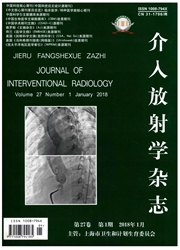

 中文摘要:
中文摘要:
目的 探讨经导管肝动脉化疗栓塞术(TACE)或肝动脉栓塞术(TAE)后胆汁瘤形成的临床表现、治疗方法及预后.方法 回顾性分析2005年1月—2013年3月行TACE/TAE后形成胆汁瘤的63例患者的临床及影像学资料,分析有无临床症状、胆汁瘤的治疗方式及临床转归.结果 63例患者中,52例胆汁瘤发生于TACE术后4周~3个月,占82.5%,11例胆汁瘤发生于TACE/TAE术后3~6个月,占17.5%.63例胆汁瘤形成患者中48例(76.2%)无临床症状,其胆汁瘤直径(2.64±2.20)cm;有症状胆汁瘤15例,胆汁瘤直径(6.98±6.57)cm,有无症状者胆汁瘤大小比较差异有显著统计学意义(P<0.01).48例无症状胆汁瘤影像学随访时间37 d至49个月,其中30例(62.5%)大小无变化,13例(27.1%)缩小,3例(6.3%)消失,1例增大,1例胆汁瘤直径3.8 cm、临近肝包膜,发生破裂形成胆汁性腹膜炎,1周后死于感染性休克、肝功能衰竭.有症状胆汁瘤15例临床表现有黄疸2例,发热11例,黄疸并有发热2例.均行穿刺置管引流,11例(71.3%)缩小,4例消失;14例临床症状缓解后拔管,置管时间53d~11个月,1例合并缺血性胆道狭窄,持续引流18个月仍反复发热.结论 胆汁瘤作为TACE/TAE的并发症之一,多发生于术后4周~3个月.无症状者,应定期影像随访,对有症状或临近肝包膜较大的胆汁瘤,应及时穿刺置管引流.
 英文摘要:
英文摘要:
Objective To investigate the clinical features,treatment,outcomes of biloma formation occurring after transcatheter arterial chemoembolization (TACE) or transcatheter arterial embolization (TAE)for liver tumors.Methods The clinical and imaging data of 63 patients,who developed biloma after TACE or TAE during the period from January 2005 to March 2013 at authors' hospital,were retrospective analyzed,focusing on the clinical symptoms,managements and clinical outcomes.Results Of the 63 patients,52 (82.5%) developed biloma within 4 weeks to 3 months after TACE,while the other 11 (17.5%) developed biloma within 3-6 months after TACE or TAE.Clinically,48 patients were asymptomatic,and the diameter of the biloma was (2.64 ± 2.20) cm.Fifteen patients were symptomatic and the diameter of the biloma was (6.98 ± 6.57) cm.Significant difference in the diameter of biloma existed between asymptomatic and symptomatic patients (P 〈 0.01).The imaging follow-up time of 48 (76.2%) asymptomatic patients ranged from 37 days to 49 months,and the tumor size showed no change in 30 cases (62.5%),and showed a shrinkage in 13 cases.The tumor disappeared in 3 cases and became enlarged in one case.The diameter of one biloma was 3.8 cm,which was located closely to the hepatic capsule and it was ruptured to cause choleperitonitis.This patient died from infection shock one week later.The clinical manifestations of 15 symptomatic patients included jaundice (n =2),fever (n =11) and jaundice with fever (n =2).After drainage,the biloma shrank in 11 cases (71.3%) and disappeared in 4 cases.The drainage tube was removed in 14 cases when their clinical symptoms were improved,the standing time of the catheter varied from 53 days to 11 months.In one case the biloma was complicated by ischemic bile duct stricture,and the drainage was kept on for 18 months,while the patient had recurrent fever.Conclusion Biloma formation is one of the complications caused by TACE and TAE.In most cases it occurs wit
 同期刊论文项目
同期刊论文项目
 同项目期刊论文
同项目期刊论文
 期刊信息
期刊信息
